The Friends of the Wildflower Garden, Inc.
Plants of the Eloise Butler Wildflower Garden
The oldest public wildflower garden in the United States
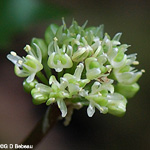
Common Name
Wild Leek (Ramp)
Scientific Name
Allium tricoccum Sol.
Plant Family
Wild Onion (Alliaceae)
Garden Location
Woodland
Prime Season
Early Summer Flowering
Wild Leek is a native perennial that first raises a cluster of basal leaves in early spring. Then the plant, in early Summer, sends up a flowering scape, at which time the leaves die back.
Leaves are medium green, smooth surfaces, smooth margins, acute tip and tapered to the base, which can have a short stalk where the leaf takes on some reddish coloration. They are ovate to ovate-elliptic in shape, and from 1-1/2 to 3 inches wide (15 to 90 mm) and 3x as long in var. tricoccum, but only 3/4 to 1-3/4 inches wide in var. burdickii. They are flat, without a keel (thicker center channel). They die back at flowering time.
Inflorescence: As the flowering scape (a stalk that is an above ground extension of the root) appears, leaves begin to whither away and disappear by the time the plant is in flower. The 4 to 12 inch erect scape is round, smooth, green to reddish green with a spathe at the top. The spathe drops away, leaving several bracts at the base, to expose an umbel (a rounded cluster), 1 to 2 inches wide, of 12 to 50 small flowers.
Flowers: Each flower has petals and sepals combined to form 6 tepals which are white to cream to yellowish, somewhat translucent, with smooth margins, oblong in shape. There are 6 stamens with white to yellow anthers, a single style and a 3-celled green ovary. Flowers and leaves have an onion odor.
Seed: The flowers mature to 3-part capsules with one shiny black seed per chamber. Seeds will persist through the winter on the dry erect scape. Seeds are slow to germinate requiring successive warn and cold moist periods. Outdoors if fresh seed is planted it will not germinate until the following year.
Varieties: Two varieties are found in North America and both are found in Minnesota - var. tricoccum has wider leaves and more flowers in the cluster; var. burdickii has leaf blades only 3/4 to 1-3/4 inches wide and about 12 to 18 flowers in the cluster. The MN DNR does not provide location data by variety. See page bottom for a list of other native Alliums in Minnesota.
Habitat: Wild Leek is a plant of the moist shady woods, not growing in exposed full sun locations, but some dappled sunlight during the growing season is good. The root is an ovoid bulb with fibrous roots; while a single bulb will start a plant, mature plants usually develop 2 to 6 bulbs on a short rhizome. The bulb is edible but small.
Names: The genus Allium is taken from the classical Latin name for garlic. The species tricoccum means '3-seeded' as in the seed capsule of this species. The author name for the plant classification, from 1789, - ‘Sol.’ is for Daniel Solander, (1733-1782), Swedish naturalist, cataloger of the natural history collections of the British Museum and who was on board the Endeavour on James Cook’s first round the world voyage as principal naturalist for Joseph Banks who led the scientific group on the voyage.
The assigned family class is in flux currently. A number of authorities moved the old world species of Allium from the Lily (Liliaceae) family and placed them in the Alliaceae. Most botanists accept that but the move of the new world species into the Alliaceae has been resisted by some. Minnesota authorities at the U of M Herbarium have accepted the move. Flora of North America discusses the reasoning but still lists them in the Lily family. In the newer classification scheme, the authorship has been assigned to ‘Aiton’ is for William Aiton (1731-1793), Scottish botanist, who succeeded Philip Miller as superintendent of the Chelsea Physic Garden and then became director of Kew Gardens, where he published Hortus Kewensis in 1789, the Garden’s catalogue of plants. Both Solander and Jonas Dryander worked with Aiton in producing the catalogue.
The alternate common name of 'Ramp' is somewhat obscure but it may be linked to the edible bulb. Some other plants with edible roots are also known as 'ramps', such as Campanula rapunculus, and the common name is thought to come from the Latin rapa for a turnip.
Comparisons: The scape, flowering after leaf die-back is unlike the other Alliums. Also the flat leaves, with a width of 15 to 90 mm, tapered base and no keel distinguishes this species from all the 95 others found in North America except for A. victorialis, which is found only in Alaska, but that species retains its leaves at flowering time.
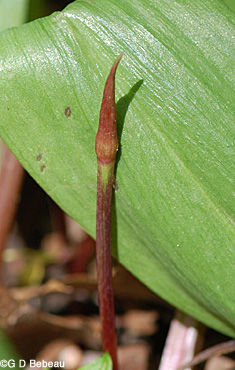
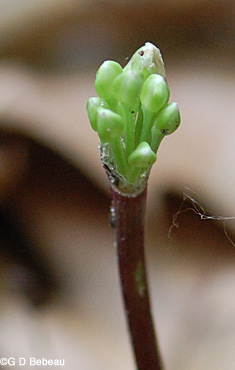
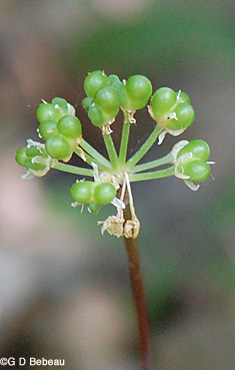
Above: The development of the flower: 1st photo - The flowering scape rises just as the leaves are dying down; 2nd photo - buds of the individual flowers forming; 3rd photo - after flowering the green three-part seed capsules form, which will be brown at maturity (see below).
Below: The basal leaves which disappear at flowering time

Below: 1st photo - The umbel of small 6-part flowers with the green 3-part ovary showing in the center of each. 2nd photo - The three-part structure develops with each section containing a black seed.
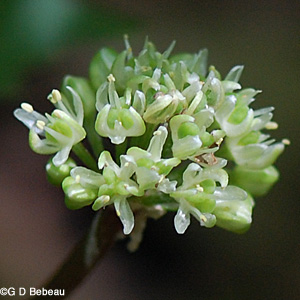
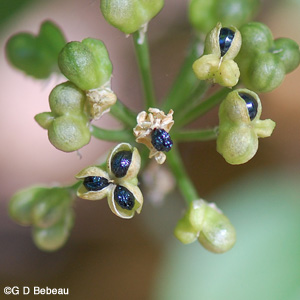
Below: 1st photo - In Autumn, look for the seed head on the stem, bare of leaves, upright or laying on the ground. 2nd photo - The glossy black seeds remain after the capsule sides fall away in late Summer.
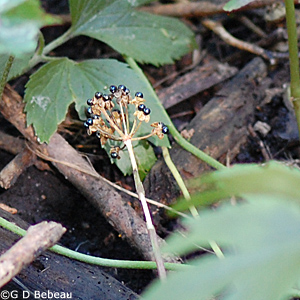
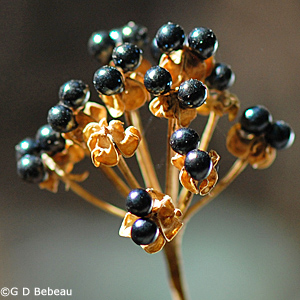
Notes: Wild Leek was not included on Eloise Butler's list of indigenous plants of the Garden area, but she did plant it on April 13, 1910 without specifying where she got the plants. On May 1, 1921 Eloise recorded planting the "narrow leaved" leak from a source near Medicine Lake (which is several miles West of the Garden). She added more in 1923 and 24. Martha Crone planted it in 1946 and it is listed in her 1951 Garden census, but not on the 1986 census, but was probably missed as it was viewable in the in the Woodland Garden soon after that. Curator Susan Wilkins has planted it as recently as 2012-13. The plant is native to the state and most of the eastern United States. In Minnesota it is found in most counties except some in far NW and far SW corner. Its range in North America is roughly from Manitoba south to Missouri and eastward to the coast. Absent in the Gulf-shore states.
Wild Leek is one of six Alliums found native in Minnesota. The others being A. canadense, Wild Garlic; A. cernuum, Nodding Wild Onion; A. schoenoprasum, Wild Chives; A. Stellatum, Prairie Onion; and A. textile, Textile onion. A tricoccum and the three with links to information sheets are found in the Garden.
Lore: Densmore (Ref. #5) reports in her study of plants used by the Chippewa the Wild Leek was taken as an emetic (to cause vomiting). One dose made as a decoction from the root was said to have a quick effect.
Fernald (Ref. #6) writes: "Dr. Huron H. Smith tells us that in the language of the Menominee Indians Wild Leek is "pitwu'tc sikaku'shia" (the skunk) and that the word 'shika'ko' or 'skunk place' is the origin of the word Chicago, which in aboriginal times was the locality of an abundance of these wild leeks." It is also reported by Fernald that "in their journey in 1674 from Green Bay to the present site of Chicago, Marquette and his party subsisted largely on A. tricoccum and A. canadense."
Return to -- Site Plan/Archive Index --or-- List of Common Plant Names -- or -- List of Scientific Names -- or --Home Page - - - Back to top.
References: Plant characteristics are generally from sources 1A, 32, W2, W3, W7 & W8 plus others as specifically applied. Distribution principally from W1, W2 and 28C. Planting history generally from 1, 4 & 4a. Other sources by specific reference. See Reference List for details.
 Identification booklet for most of the flowering forbs and small flowering shrubs of the Eloise Butler Wildflower Garden. Details Here.
Identification booklet for most of the flowering forbs and small flowering shrubs of the Eloise Butler Wildflower Garden. Details Here.
©2016
Friends of the Wildflower Garden, Inc. Text and photos are by G. D. Bebeau unless otherwise credited. "www.friendsofeloisebutler.org"
080721